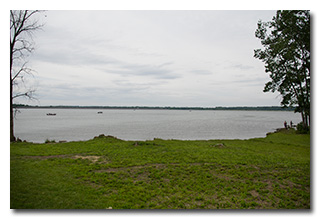
by William Eric McFadden
Three Hundred Miles, Five Parks, and One Very Long Day — Park 1
From the park's website:
-
Located in central Ohio, the 4,630-acre Alum Creek State Park provides access to the park's 3,387-acre reservoir, a boater's paradise. Sunseekers can mingle with one another on Ohio's largest inland beach. Rolling hills and quiet coves nestled among shale cliffs offer a hub of recreational activity minutes from Ohio's capital city.
Pictures
- The park sign; photo by Miles McFadden
- The under-test drive-on mast mount
- Eric operating; photo by Miles McFadden
- A view of the reservoir
Description
On Saturday, June 8, 2019 two members of the Southeast Ohio Radio Adventure Team undertook an aggressive operation to activate five POTA units in central Ohio. Eric McFadden, WD8RIF, and Miles McFadden, KD8KNC, drove over 300 miles, encountered two state route road-closures, and were on the road for almost sixteen hours to visit and activate Alum Creek State Park (K-1933), Delaware State Park (K-1946), Mt. Gilead State Park (K-1979), Mohican-Memorial State Forest (K-5444), and Mohican State Park (K-1977) in central Ohio as part of the the Parks on the Air (POTA; link) program.
The first stop was Alum Creek State Park, K-1933.
 Eric and Miles arrived at Alum Creek State Park's Africa Road boat ramp area at 1356 UTC.
After exploring the area for few minutes, the duo elected to set up the station in a quiet cul-de-sac away
from the traffic of pick-up trucks and boat trailers. Eric chose to test his newly-built drive-on mast support (photo)
and his recently-acquired Jackite 31' telescoping fiberglass pole. The drive-on mast support worked well but
in deploying the Jackite pole, Eric found that the mast sections needed more aggressive pull-and-twist
than he is used to applying with the aging MFJ-1910 33' fiberglass mast he has been using since 2016 and the
top elements collapsed once before Eric got it right. Once the Jackite was up, it worked very well. Eric
deployed his usual 28½' end-fed wire vertical with three 17' radials on the Jackite pole and deployed
his Elecraft KX3 on his folding camping chair's swing-up table. Because Eric wasn't sure his usual NiMH battery
packs would survive five activations, Eric chose to power his KX3 at this first park using a 5Ah SLA battery.
Eric was on the air by 1411 UTC.
Eric and Miles arrived at Alum Creek State Park's Africa Road boat ramp area at 1356 UTC.
After exploring the area for few minutes, the duo elected to set up the station in a quiet cul-de-sac away
from the traffic of pick-up trucks and boat trailers. Eric chose to test his newly-built drive-on mast support (photo)
and his recently-acquired Jackite 31' telescoping fiberglass pole. The drive-on mast support worked well but
in deploying the Jackite pole, Eric found that the mast sections needed more aggressive pull-and-twist
than he is used to applying with the aging MFJ-1910 33' fiberglass mast he has been using since 2016 and the
top elements collapsed once before Eric got it right. Once the Jackite was up, it worked very well. Eric
deployed his usual 28½' end-fed wire vertical with three 17' radials on the Jackite pole and deployed
his Elecraft KX3 on his folding camping chair's swing-up table. Because Eric wasn't sure his usual NiMH battery
packs would survive five activations, Eric chose to power his KX3 at this first park using a 5Ah SLA battery.
Eric was on the air by 1411 UTC.
Band conditions on 40, 30, and 20m were excellent and in just about forty minutes Eric easily made twenty QSOs, twice the number of QSOs required for a valide POTA activation.
Starting on 40m, Eric began calling "CQ POTA" and was rewarded at 1415 UTC with a reply from WB9OWN. QSOs on 40m came quickly after that with Eric's eighth QSO, with W4AVP, coming ten minutes later at 1425 UTC.
Switching to 20m, Eric called "CQ POTA" and his first QSO on 20m was with K6YK in California at 1431 UTC. Eight minutes brought a total of four QSOs on 20m, with Eric's final QSO on 20m coming at 1439 UTC with AE4ZR.
Switching to 30m, Eric's first QSO there came at 1443 UTC with big-time POTA Hunter W9AV. Twelve minutes brought Eric eight QSOs on 30m with his twentieth and final QSO coming at 1453 UTC with W8SUN.
Eric and Miles tore down the station and took a few minutes to photograph the view of the reservoir before hitting the road for the second of five parks, Delaware State Park, K-1946, where they were to be joined by friend and fellow SEORAT-member Mike Hansgen, K8RAT.
All Eric's QSOs were CW and were made at the 5-watt level. Miles didn't operate but did most of the expedition photography, helped with set-up and tear-down, and helped with navigation.
Eric also submitted his log to the World Wide Flora and Fauna in Amateur Radio (WWFF; link) program although he didn't make enough QSOs to to achieve a valid activation within the program which requires 44 QSOs be made. However, the WWFF program allows these 44 QSOs be made over any number of visits so a valid activation within WWFF is still possible if subsequent visits to the park are made.
(return)